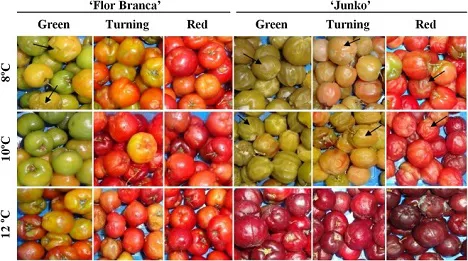Acerola (Malpighia emarginata) is native in Central and Northern South America and is considered a super-fruit due to its high vitamin C content. Acerola postharvest life depends highly on the maturity stage at harvest and storage temperatures.
Scientists at Embrapa in Petrolina (Brazil) have determined the optimal harvest maturity and storage temperature for Flor Branca and Junko acerolas produced in the São Francisco Valley in the Northeast of Brazil. For the study, acerolas were harvested at maturity stages green (green skin color at 18 days after full bloom), turning (initial skin color changes from green to red at 20 days after full bloom) and red (red skin color at 22 days after full bloom) and were stored at 8, 10 and 12 °C with RH of 90–95% for 14 days. The scientists refer "Our results showed that Flor Branca and Junco acerolas should be harvested at the maturity stage green with density lower than 1 g/cm3 and stored at 10 °C and 12 °C, respectively, in order to maintain high fruit quality".

Green fruits with a density lower than 1 g/cm3 were used for the capacity to change skin color from green to red after harvest. Fruit harvested at maturity stage green showed better storage potential than fruit harvested at more advanced stages. Storage temperatures of 10°C for Flor Branca and 12°C for Junko acerolas harvested at maturity stage green maintained fruit quality without chilling injury, keeping the fruit greener with higher ascorbic acid content and flesh firmness during 14 days of storage. In both acerola cultivars, lower storage temperatures resulted in chilling injury incidence and the harvest at maturity stage green resulted in lower fruit decay incidence and weight loss during 14 days of storage.
Source: Bruna Silva Ribeiro, Sergio Tonetto de Freitas, 'Maturity stage at harvest and storage temperature to maintain postharvest quality of acerola fruit', 2020, Scientia Horticulturae, Volume 260, 108901.
